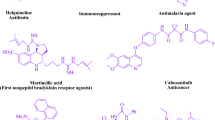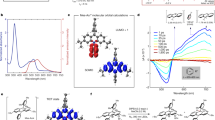Abstract
One electron reduction of N-alkyl-4-picolinium (NAP) esters initiates C-O bond scission releasing a carboxylate anion. Previous experiments have demonstrated that this process can be initiated by photoinduced electron transfer from an electron-donating sensitizer. In the present study it is demonstrated that a comparable photorelease process can be initiated by photolysis of an electron acceptor (mediator), which in turn abstracts an electron from a ground state electron donor. The resulting mediator anion radicals donate an electron to the NAP ester, triggering release of the carboxylate anion. It is demonstrated that when benzophenone is used as a mediator, higher quantum yields for ester decomposition can be achieved compared with sensitizers that do direct photoinduced electron transfer.
Similar content being viewed by others
References
M. C. Pirrung, L. Fallon and G. McGall, Proofing of photolithographic DNA synthesis with 3′,5′-dimethoxybenzoincarbonyl-protected deoxynucleoside phosphoramidites, J. Org. Chem., 1998, 63, 241–246.
M. C. Pirrung, W. H. Pieper, K. P. Kaliappan and M. R. Dhananjeyan, Combinatorial discovery of two-photon photoremovable protecting groups, Proc. Natl. Acad. Sci. U. S. A., 2003, 100, 12548–12553.
G. Marriot and J. W. Walker, Caged peptides and proteins: New probes to study polypeptide function in complex biological systems, Trends Plant Sci., 1999, 4, 330–334.
A. Heckel and G. Mayer, Light regulation of aptamer activity: An anti-thrombin aptamer with caged thymidine nucleobases, J. Am. Chem. Soc., 2005, 127, 822–823.
V. N. R. Pillai, Photoremovable protecting groups in organic synthesis, Synthesis, 1980, 1–26.
Y. V. Il’ichev, M. A. Schworer and J. Wirz, Photochemical reaction mechanisms of 2-nitrobenzyl compounds: Methyl ethers and caged ATP, J. Am. Chem. Soc., 2004, 126, 4581–4595.
C. Grewer, J. Jager, B. K. Carpenter and G. P. Hess, A new photolabile precursor of glycine with improved properties: A tool for chemical kinetic investigations of the glycine receptor, Biochemistry, 2000, 39, 2063–2070.
J. Literak, J. Wirz and P. Klan, 2,5-Dimethylphenacyl carbonates: A photoremovable protecting group for alcohols and phenols, Photochem. Photobiol. Sci., 2005, 4, 43–46.
P. Klán, A. P. Pelliccioli, T. Pospisil and J. Wirz, 2,5-Dimethylphenacyl esters: A photoremovable protecting group for phosphates and sulfonic acids, Photochem. Photobiol. Sci., 2002, 1, 920–923.
R. S. Rock and S. I. Chan, Preparation of a water-soluble “cage” based on 3′,5′-dimethoxybenzoin, J. Am. Chem. Soc., 1998, 120, 10766–10767.
C. S. Rajesh, R. S. Givens and J. Wirz, Kinetics and mechanism of phosphate photorelease from benzoin diethyl phosphate: Evidence for adiabatic fission to an α-keto cation in the triplet state, J. Am. Chem. Soc., 2000, 122, 611–618.
R. S. Givens, A. Jung, C.-H. Park, J. Weber and W. Bartlett, New photoactivated protecting groups. 7. p-hydroxyphenacyl: A phototrigger for excitatory amino acids and peptides, J. Am. Chem. Soc., 1997, 119, 8369–8370.
R. S. Givens, J. F. W. Weber, P. G. Conrad, G. Orosz, S. L. Donahue and S. A. Thayer, New phototriggers 9: p-Hydroxyphenacyl as a C-terminal photoremovable protecting group for oligopeptides, J. Am. Chem. Soc., 2000, 122, 2687–2697.
T. Furuta, H. Torigai, M. Sugimoto and M. Iwamura, Photochemical properties of new photolabile cAMP derivatives in a physiological saline solution, J. Org. Chem., 1995, 60, 3953–3956.
T. Furuta, S. S.-H. Wang, J. L. Dantzker, T. Dore, E. J. Bybee, E. M. Callaway, W. Denk and R. Y. Tsien, Brominated 7-hydroxycoumarin-ylmethyls: Photolabile protecting groups with useful cross-sections for two-photon photolysis, Proc. Natl. Acad. Sci. U. S. A., 1999, 96, 1193–2000.
G. Papageorgiou, D. C. Ogden, A. Barth and J. E. T. Corrie, Photorelease of carboxylic acids from 1-acyl-7-nitroindolines in aqueous solution: Rapid and efficient photorelease of l-glutamate, J. Am. Chem. Soc., 1999, 121, 6503–6504.
M. Canepari, L. Nelson, G. Papageorgiou, J. E. T. Corrie and D. C. Ogden, Photochemical and pharmacological evaluation of 7-nitroindolinyl- and 4-methoxy-7-nitroindolinyl-amino acids as novel, fast caged neurotransmitters, J. Neurosci. Methods, 2001, 112, 29–42.
Z. Li, Y. Wan and A. G. Kutateladze, Dithiane-based photolabile amphiphiles: Toward photolabile liposomes, Langmuir, 2003, 19, 6381–6391.
T. Hamada, A. Nishida and O. Yonemitsu, A new amino protecting group readily removable with near ultraviolet light as an application of electron-transfer photochemistry, Tetrahedron Lett., 1989, 30, 4241–4244.
G. Papageorgiou, D. C. Ogden and J. E. T. Corrie, An antenna-sensitized nitroindoline precursor to enable photorelease of l-glutamate in high concentrations, J. Org. Chem., 2004, 69, 7228–7233.
G. Papageorgiou, M. Lukeman, P. Wan and J. E. T. Corrie, An antenna triplet sensitiser for 1-acyl-7-nitroindolines improves the efficiency of carboxylic acid photorelease, Photochem. Photobiol. Sci., 2004, 3, 366–373.
A. Banerjee and D. E. Falvey, Protecting groups that can be released through photoinduced electron transfer: Mechanistic and product studies of photosensitized release of carboxylates from phenacyl esters, J. Org. Chem., 1997, 62, 6245–6251.
C. Sundararajan and D. E. Falvey, C-O bond fragmentation of 4-picolyl and N-methyl-4-picolinium esters triggered by photochemical electron transfer, J. Org. Chem., 2004, 69, 5547–5554.
C. Sundararajan and D. E. Falvey, Photorelease of carboxylic acids, amino acids, and phosphates from N-alkylpicolinium esters using photosensitization by high wavelength laser dyes, J. Am. Chem. Soc., 2005, 127, 8000–8001.
C. Sundararajan and D. E. Falvey, Photolytic release of carboxylic acids using linked donor-acceptor molecules: Direct versus mediated photoinduced electron transfer to N-alkyl-4-picolinium esters, Org. Lett., 2005, 7, 2631–2634.
T. L. Morkin, N. J. Turro, M. H. Kleinman, C. S. Brindle, W. H. Kramer and I. R. Gould, Selective solid state photooxidant, J. Am. Chem. Soc., 2003, 125, 14917–14924.
H. Rinderhagen and J. Mattay, Cyclopropyl silyl ether radical cations. Part 1: Synthetic applications in radical/radical cationic cascade reactions, Chem.-Eur. J., 2004, 10, 851–874.
S. L. Murov, I. Carmichael, and G. L. Hug, Handbook of photochemistry, Marcel Dekker Inc., New York, 2nd edn, 1993.
A. J. Bard, K. S. V. Santhanam, J. T. Maloy, J. Phelps and L. O. Wheeler, Steric effects and the electrochemistry of phenyl-substituted anthracenes and related compounds, Discuss. Faraday Soc., 1968, 45, 167–174.
T. Shida, Electronic absorption spectra of radical ions, Elsevier, Amsterdam, 1988.
M. Goez and B. H. M. Hussien, Photoionization of xanthone via its triplet state or via its radical anion, Phys. Chem. Chem. Phys., 2004, 6(24), 5490–5497.
Author information
Authors and Affiliations
Corresponding author
Rights and permissions
About this article
Cite this article
Sundararajan, C., Falvey, D.E. Photorelease of carboxylic and amino acids from N-methyl-4-picolinium esters by mediated electron transfer. Photochem Photobiol Sci 5, 116–121 (2006). https://doi.org/10.1039/b511269a
Received:
Accepted:
Published:
Issue Date:
DOI: https://doi.org/10.1039/b511269a




